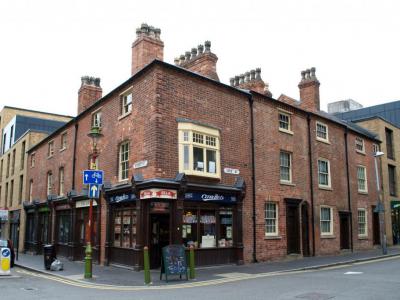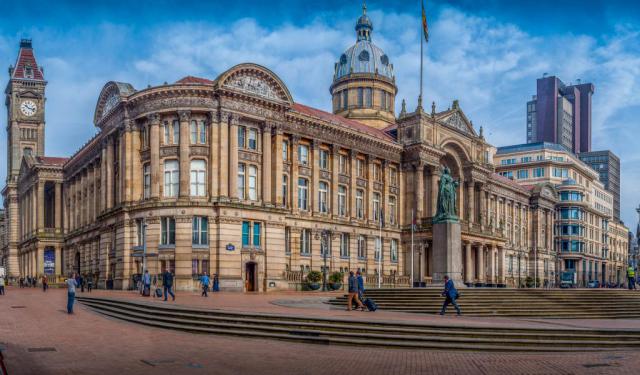Birmingham Back to Backs, Birmingham (must see)
Following the industrial revolution in Britain, there were great migrations of landless people flocking to the cities for work. Birmingham, always the foremost city of industry, built thousands of so-called back-to-back houses to accommodate the influx. The houses were overcrowded and built around shared courtyards, "back-to-back."
Also known as British terraced housing, the back-to-backs were declared unsatisfactory. No more such housing was built after the Public Health Act of 1875. They were replaced by byelaw terraced houses that were not much better.
The back-to-back houses were two to three stories high. They were found mostly in depressed inner-city areas of Birmingham. In the early 1970s most of the back-to-backs had been demolished. Many tenants were moved to council houses and flats. Most of them however settled in housing estates.
The combination of two houses back to back and sharing a common yard was referred to as a "court." Many of the courts were occupied by workers who worked at home in specialized tasks. They labored at such things as button making, glasswork, woodwork, and leather tailoring. There were also skilled trades including jewelry.
Overcrowding was common. In Court 15 for instance, now on display, there had been over 500 families. (Not all at one time, naturally.)
Ground floors were often converted into shops. Trades practiced included cycle maker, hairdresser, ticket writer, fruiter seller, and furniture dealer. A pearl button driller, working at home in court 15 shared her workplace/home with her mother and five children. A glass eye maker also lived in court 15 with his wife and eight children.
This type of housing remained in use until 1966. The buildings were finally declared unfit for human habitation and the tenants were forced to leave.
Heating would come from fireplaces, water from a pump in the yard, and sanitary needs from an outhouse. All things considered, perhaps the tenants did not mind leaving.
Why You Should Visit:
To see how far ordinary people have come and appreciate the blessings we enjoy.
Also known as British terraced housing, the back-to-backs were declared unsatisfactory. No more such housing was built after the Public Health Act of 1875. They were replaced by byelaw terraced houses that were not much better.
The back-to-back houses were two to three stories high. They were found mostly in depressed inner-city areas of Birmingham. In the early 1970s most of the back-to-backs had been demolished. Many tenants were moved to council houses and flats. Most of them however settled in housing estates.
The combination of two houses back to back and sharing a common yard was referred to as a "court." Many of the courts were occupied by workers who worked at home in specialized tasks. They labored at such things as button making, glasswork, woodwork, and leather tailoring. There were also skilled trades including jewelry.
Overcrowding was common. In Court 15 for instance, now on display, there had been over 500 families. (Not all at one time, naturally.)
Ground floors were often converted into shops. Trades practiced included cycle maker, hairdresser, ticket writer, fruiter seller, and furniture dealer. A pearl button driller, working at home in court 15 shared her workplace/home with her mother and five children. A glass eye maker also lived in court 15 with his wife and eight children.
This type of housing remained in use until 1966. The buildings were finally declared unfit for human habitation and the tenants were forced to leave.
Heating would come from fireplaces, water from a pump in the yard, and sanitary needs from an outhouse. All things considered, perhaps the tenants did not mind leaving.
Why You Should Visit:
To see how far ordinary people have come and appreciate the blessings we enjoy.
Want to visit this sight? Check out these Self-Guided Walking Tours in Birmingham. Alternatively, you can download the mobile app "GPSmyCity: Walks in 1K+ Cities" from Apple App Store or Google Play Store. The app turns your mobile device to a personal tour guide and it works offline, so no data plan is needed when traveling abroad.
Birmingham Back to Backs on Map
Sight Name: Birmingham Back to Backs
Sight Location: Birmingham, England (See walking tours in Birmingham)
Sight Type: Attraction/Landmark
Guide(s) Containing This Sight:
Sight Location: Birmingham, England (See walking tours in Birmingham)
Sight Type: Attraction/Landmark
Guide(s) Containing This Sight:
Walking Tours in Birmingham, England
Create Your Own Walk in Birmingham
Creating your own self-guided walk in Birmingham is easy and fun. Choose the city attractions that you want to see and a walk route map will be created just for you. You can even set your hotel as the start point of the walk.
Birmingham Historical Buildings Tour
Although existent as a settlement since the early 7th century AD, Birmingham, UK is a relatively young city that has grown rapidly, as a result of the Industrial Revolution, from the 18th century onward. Thus, the local architecture is overwhelmingly a product of the 18th, 19th, and 20th centuries, with little survived from the earlier days.
Traces of the ancient settlement, dating back to... view more
Tour Duration: 2 Hour(s)
Travel Distance: 3.6 Km or 2.2 Miles
Traces of the ancient settlement, dating back to... view more
Tour Duration: 2 Hour(s)
Travel Distance: 3.6 Km or 2.2 Miles
Birmingham Introduction Walking Tour
The word Birmingham derives from the Old English term "Beormingas." A Beorminga was a person who was one of "Beorma's people." Who was Beorma? Who knows? Something was always stirring around Birmingham.
In 1166, Peter de Bermingham received a charter from the King, Henry II, to build a market at his castle (Peter's castle, not Henry's). As Lord of the Manor... view more
Tour Duration: 2 Hour(s)
Travel Distance: 3.2 Km or 2 Miles
In 1166, Peter de Bermingham received a charter from the King, Henry II, to build a market at his castle (Peter's castle, not Henry's). As Lord of the Manor... view more
Tour Duration: 2 Hour(s)
Travel Distance: 3.2 Km or 2 Miles





